With the change of seasons comes the obligatory change of winter and summer clothes. It seems like storing clothes is easy; we just push them deeper into the closet. But is that really the best way to store clothes for a longer period of time and not damage them?
To store seasonal clothes without damaging them, it’s important to wash and mend them before we store them. After that, a suitable container must be chosen. Using dryer sheets and mothballs can also help keep our seasonal clothes smelling good and prevent them from being destroyed by moths.
In this article, I’ll explain how to store your seasonal clothes in detail. I’ll also reveal a few tricks and tips to keep them in the best condition possible until they are ready to be worn again.
1. Sort Out the Clothes

Before storing your clothes, the best thing to do is to sort them out. Some clothes are perhaps nearing their ‘shouldn’t-be-worn-anymore’ date, while some you probably never even put on. Since most clothes are seasonal, an excellent way to know it’s time to pass a garment on or donate it is if you haven’t worn it for six months.
Choose which items to store and which to donate – clothes that don’t fit or aren’t ‘in’ anymore shouldn’t have a place in your closet. Sorting out the clothes will also help you determine which pile should be stored in what way, which will make your life easier further down the line.
Here is a great video that will teach you to do a four-pile purging method you can find on YouTube:
If you want more details on cleaning out your clothes, check out this dedicated article I created for you.
2. Wash the Clothes You Plan To Store

Never store your clothes dirty or damaged, thinking you’ll take care of that when you take them out next time. Leaving things stained or smelly for a long time will only help lock in the dirt and smells, making them harder to clean later. Also, the smell of sweat attracts moths, so you might find your clothes dirty and full of holes when you pull them out of storage.
Take care of hems, broken zippers, and missing buttons – it might not seem like a big deal to you now, but you’ll be thankful for it later.
If you are storing your seasonal clothes in the closet, clean the closet out and let some air in. Get rid of all the dust and use a moth repellant like Aromatic Cedar Blocks for Clothes Storage w/ Cedar Oil you can find on Amazon (paid link). These cedar blocks renew the freshness of your closet and protect the clothes from moths.
The organic red cedar wood gives a crisp natural smell to the wardrobe that repels moths and can be renewed when needed with the natural cedar spray that comes in the packet. The planks are also cleverly shaped for hanging in the wardrobe and carefully polished to prevent damage to clothes from hangnails or sharp edges.
Wash the clothes and give them an additional rinse to prevent the formation of detergent scum on the clothes. When stored, the detergent scum will decay and break down, causing those pesky yellow stains on your crispy white clothes. For the same reason, avoid using bleach since it can cause the same thing.
Also, don’t iron the seasonal clothing or use starch before storing them. Starch and ironing can weaken the fabric and cause them to rip all along the creases.
3. Choose the Container According to the Material From Which the Clothes Are Made
Not all clothes are made to be stored the same way – some need breathable bags, some need to be hung, and some should never, under any circumstance, be vacuum sealed. Here is a short guide:
Cardboard Boxes

Cardboard boxes are a good storage option if you plan to store the items for only a few months and if the conditions are ideal. Cardboard doesn’t do well with moisture, and it attracts bugs, so be mindful of that if you decide to use them.
Label the cardboard boxes – since they aren’t see-through, you’ll have a hard time guessing what is in each of them.
Plastic Containers
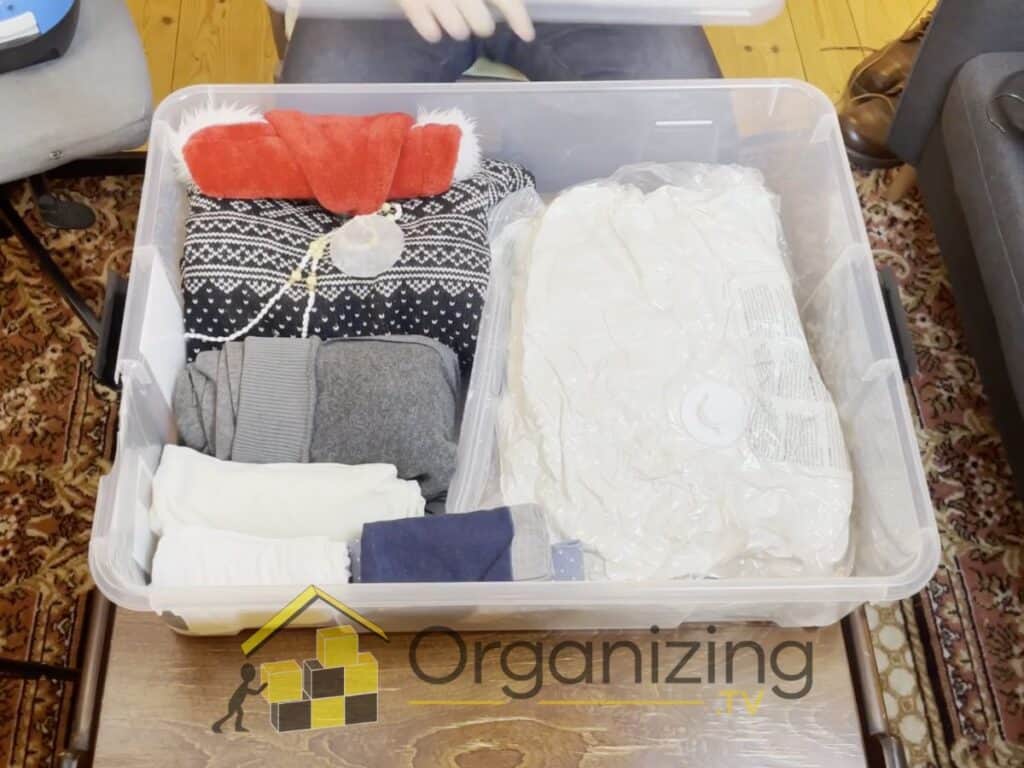
Plastic containers are the optimal option for storing your seasonal clothes. Since the containers are sealed, the clothes can’t get damaged. They are also practical because you can see what is in them, so you don’t have to open box after box to find a single clothing item. If the containers aren’t see-through, make sure to label them.
To allow some air to circulate inside your plastic containers, don’t pack the clothes in too tight. This will also spare you stubborn creases that will develop if the clothes are jammed in there like sardines.
Here is a video with a wrinkle-free folding method for T-shirts that will allow you to pack more into your plastic container without having to worry if the T-shirts will come out looking like a mess:
Old Suitcases
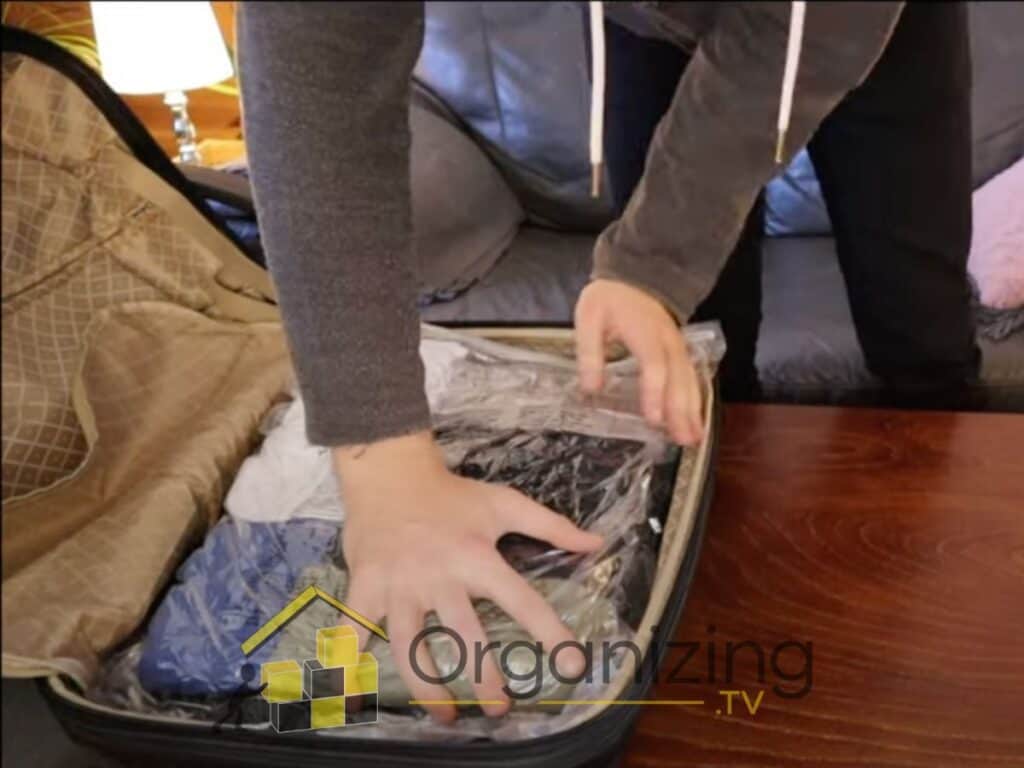
As an alternative to plastic containers and cardboard boxes, you can use old suitcases. They are an excellent option for short-term storage, and if you have some old-school ones in your attic or the basement, they can also be a statement piece in any room – decore and storage, all in one!
Garment Bags
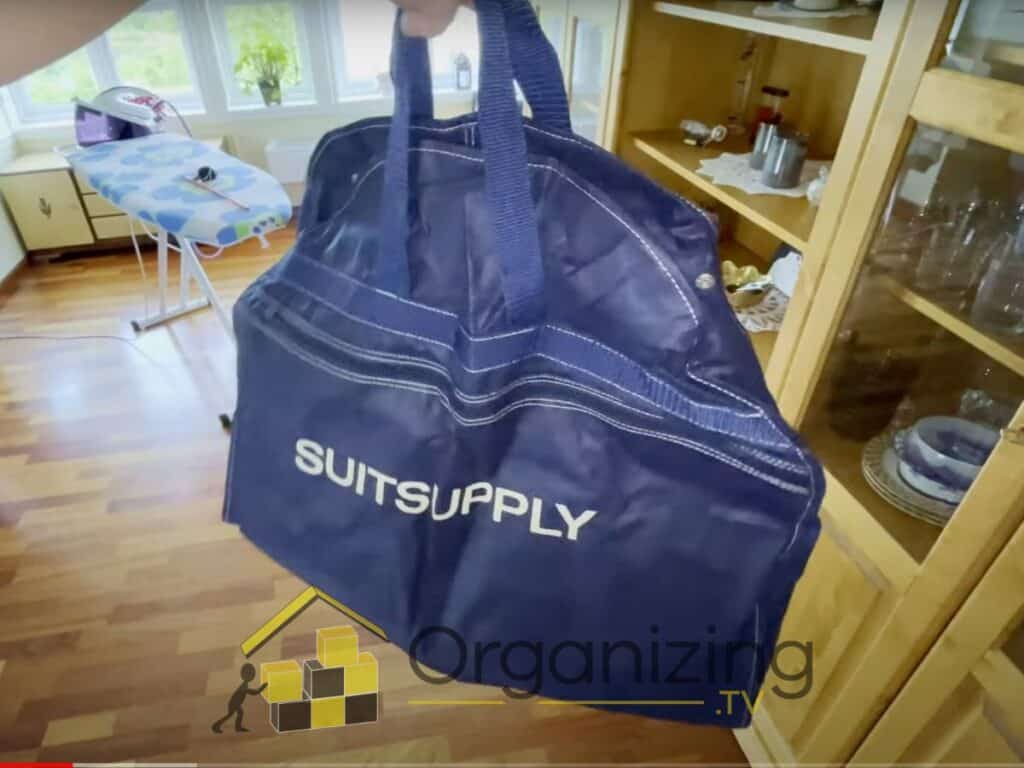
Unlike cotton, polyester, viscose, and similar clothing items, clothes made from stretchy materials and knitwear shouldn’t be hung under no circumstances – if you hang them, they will lose their shape.
On the other hand, things like coats, suits, and silk or satin clothes should be hung to prevent creasing. The best way to store this kind of clothing is in hanging garment bags. If your wardrobe is full and you have a lot of clothes to hang, try using a garment rack. I recommend this Adjustable Rolling Closet Organizer Rack from Amazon.

This heavy-duty double-hanging rod rolling rack allows for better space utilization by providing you with two rods for hanging your clothes. It also has a bottom steel mesh shelf and locking wheels mechanism to keep the rack steady and in place.
Here is an excellent article that will show you if you should fold or hang your clothes, and if hanging them, what hangers to use.
The best garment bags are made from natural fibers like cotton to allow the clothes to breathe. If you have plastic garment bags in a long-term storing situation, mold can develop because they keep the moisture in. To prevent that from happening, every so often, take the clothes out of the garment bag and let them air out in the open.
Vacuum Bags
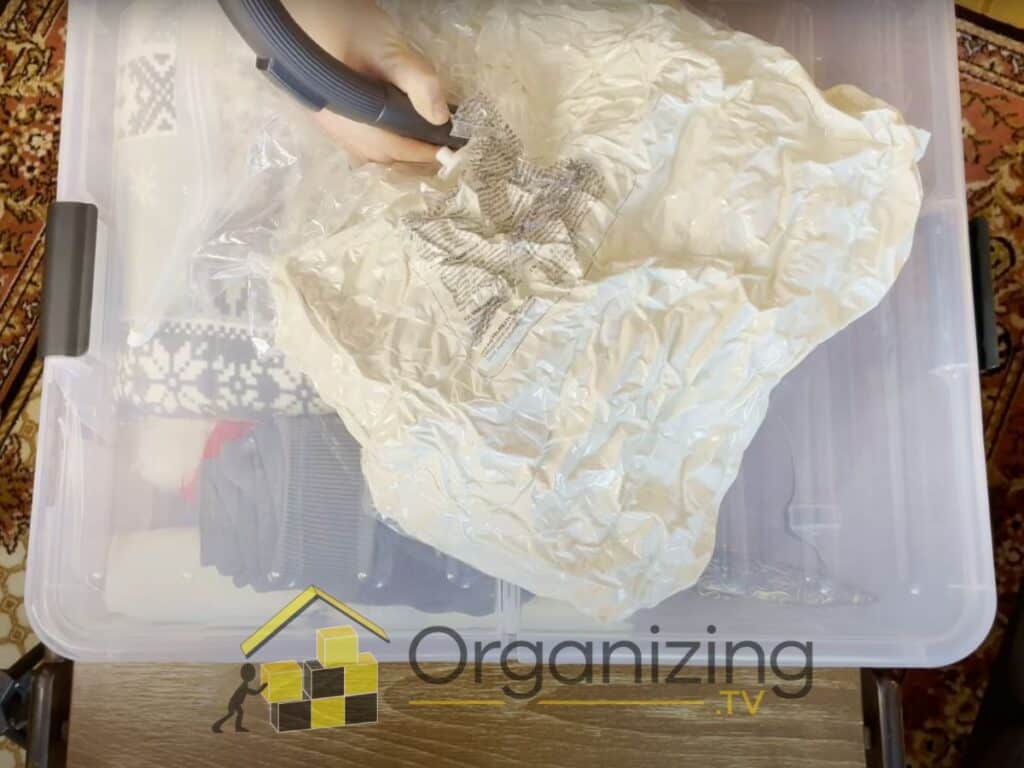
Vacuum bags are a fantastic option for storing seasonal clothes – they take up less space than plastic containers or cardboard boxes, but you can keep the same amount of clothes in them, and they are dust-proof and water-resistant.
When using vacuum bags, keep in mind that some things shouldn’t be stored in them. Cotton, polycotton, viscose, spandex, polyester, and similar materials will come out of a vacuum bag in the same shape they came in.
Delicate things and fluffy garments full of air, like insulated jackets, will lose their shape if stored in an air-free environment for a prolonged period of time, and it will be really tough to get them puffed up again.
4. Find New Places To Store Your Clothes
If you are like me, your closet is already overfilled, so there is no need to store your seasonal clothes in it. Free up some space by utilizing other places in your home.
Use the area under your bed for storing boxes or the high places that are standing empty and unused. Plastic containers and vacuum bags can also be stored in your garage, basement, or attic since they don’t allow the elements to affect the clothes.
If you already own a storage facility and have lots of seasonal clothes, keeping them there will free up a lot of space in your home and your closet. Just make sure the area is well-ventilated and dry to avoid damaging the clothes.
Tips and Tricks
Now that we know how to sort out seasonal clothing and where to store them, here are a few tips and tricks that will make packaging them easier. You can also find solutions to some after-unpacking problems here:
- When packing up your cardboard boxes and plastic containers, fold the clothes and put them into rows instead of on top of each other. This will allow you to fit more in while keeping them more accessible to inspect later.
- Line the folds with acid-free paper to prevent creasing when folding cashmere and similarly delicate items. That way, they’ll come out of storage looking the same as they did when you put them in.
- Don’t roll the socks in a ball – this will make them lose their elasticity. Instead, opt for folding them on top of each other.
- Don’t hang clothing items that have a lot of weight, like bulky wool sweaters. If you hang them, the weight will pull them down, making them lose their shape. The same applies to clothing that has beading or hanging adornments on them.
- Store your bras together with the cups inside each other. This will prevent them from losing their form and the support they provide. Here is a YouTube video with another folding method:
- If you are using mothballs, don’t use too many. They contain pesticides and can be toxic for your children and pets.
- Take clothing out of storage to air them out every few months. This is exceptionally important if you are storing clothes for a longer time – wool and other natural fibers need to breathe.
- If you don’t want to buy vacuum bags or the ones you have keep letting air in, use regular trash bags and vacuum cleaner. Take the bag opening in your hand, fit it tightly around the vacuum cleaner pole, and suck the air out of the bag. The effect will be the same, and the price much lower.
- If you are storing your seasonal clothes in the closet or on the rack, use drop hangers to utilize space better. Try this House Day Magic Hangers from Amazon – it can hold 12 garments vertically or 6 horizontally, saving you much needed space.
- In case your stored seasonal clothes have developed an odor, air dry them and spray them with a mixture of water and vinegar. This half and half mixture will kill the bacteria, eliminate the smell, and evaporate after a while, so there is no need to worry about your clothes smelling vinegar.
- Stay away from bleach to prevent the yellow staining on your stored white clothes. It causes the fabric to deteriorate and get a yellow hue. Also, don’t overuse washing detergent, and make sure the clothes are rinsed well.
- After removing your clothes from storage, use a mix of hydrogen peroxide and soda on the stain to get rid of the yellow staining. Keep the garment soaked for 8 hours, then wash on the hottest setting and air dry in the sun.
- If you have stored a puffy jacket or something similar in a vacuum bag and it has lost its shape, don’t despair. Put the jacket into the tumble dryer with tennis balls or dryer balls. The balls bouncing around will fluff up the item in no time.
Conclusion
When storing your seasonal clothes, first start by deciding what to store and what to donate. Wash the clothes thoroughly and make sure they are well-dried to prevent the formation of mildew. Store the clothes in appropriate containers and take care in deciding what to hang and what to fold.
Make sure to pick the optimal place for storing the containers and air the clothes out every now and again. With the directions, tips, and tricks in this article, your clothes will come out of storage looking pristine and smelling like roses.
If you want to learn more about how to organize your wardrobe, I invite you to check out my 14-day challenge here.
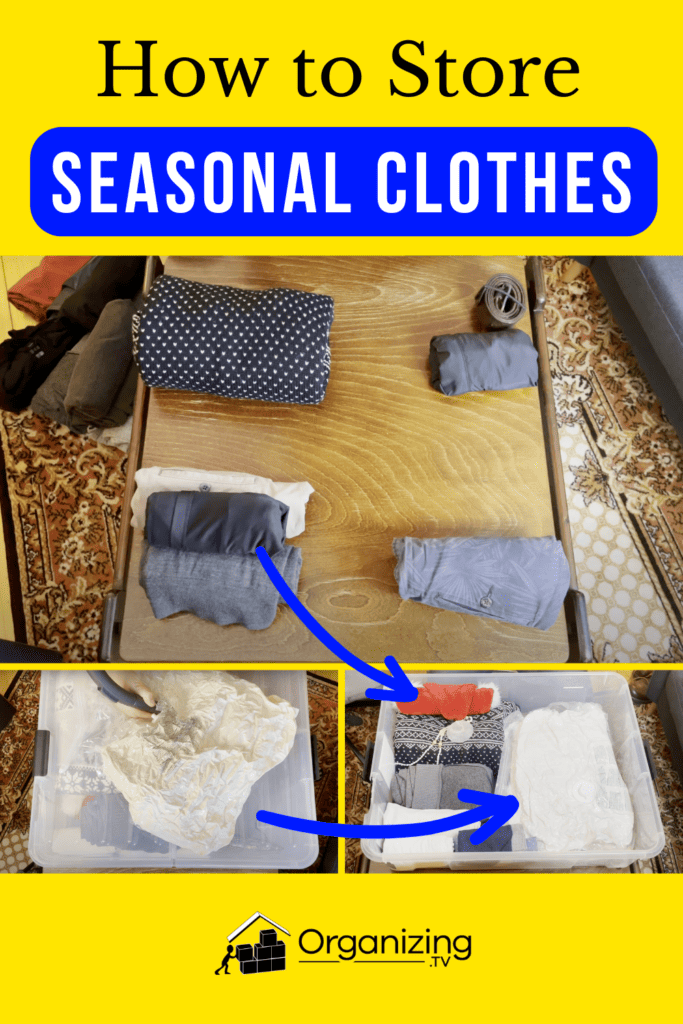

I’m an expert wardrobe organizer and a bit of a clean freak. I created this website and its YouTube channel to share practical guides about laundry and organizing. My teachings have been featured in multiple large news publications, and I’ve self-published two wardrobe organizing books and an entire course on the subject.
